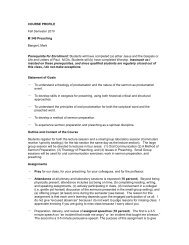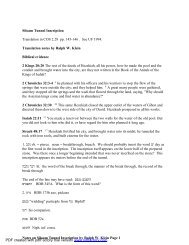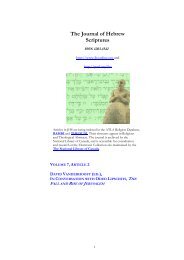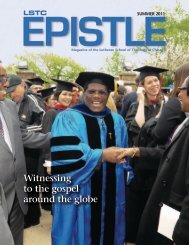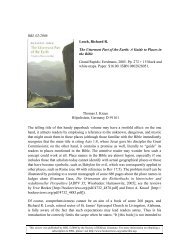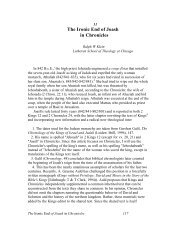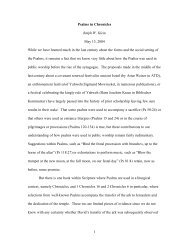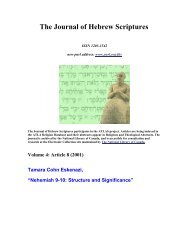Metacommentating Amos* Metacommentary, what is that ... - Fontes
Metacommentating Amos* Metacommentary, what is that ... - Fontes
Metacommentating Amos* Metacommentary, what is that ... - Fontes
Create successful ePaper yourself
Turn your PDF publications into a flip-book with our unique Google optimized e-Paper software.
2 Interested Partiesus <strong>that</strong> it has been kept from us. We innocent members of thepublic, who go on laying out good money on commentaries,need protection against these commentators who are failing totell us <strong>what</strong> it <strong>is</strong> they are failing to tell us. So it becomes anurgent public duty to create a neighbourhood watch committeeof metacommentators who will investigate for us how we arebeing shortchanged.You can search high and low for metacommentary on Amosand Amos commentators, for it <strong>is</strong> a rare scholar who will stepoutside the ideology of the text and notice how severely traditionalcommentary has been constrained by the outlook of thetext. But I did find one, whose femin<strong>is</strong>t perspective gave her avantage point, outside the text, from which the Amos landscapesuddenly took on new and surpr<strong>is</strong>ing contours. Judith Sanderson,in The Women’s Bible Commentary, noticed, as everyone elsehas, how the oracles of Amos vigorously condemn the wealthywomen of Samaria for oppressing the poor, but also, as no oneelse has, <strong>that</strong> they they do not champion the women amongthose poor. And when Amos condemns the wealthy women ofSamaria, because Sanderson <strong>is</strong> a femin<strong>is</strong>t reader she does notautomatically adopt the prophet’s standpoint, but suspects <strong>that</strong>h<strong>is</strong> condemnation <strong>is</strong> yet another scapegoating of women, whoare being blamed now not only for sexual sins (as usual) but forsocial and economic injustices in society as well. 1 ‘A survey ofmodern commentaries on Amos 4.1 reveals the alacrity withwhich women are blamed for societies’ evils, [and] their relativepowerlessness <strong>is</strong> d<strong>is</strong>regarded’, she writes, metacommentatingly. 2She <strong>is</strong> quite right; but her femin<strong>is</strong>t critique <strong>is</strong> only a paradigm forseveral types of critic<strong>is</strong>m <strong>that</strong> can be made. 31 . These women, we must recall, are ‘the pampered darlings of societyin Israel’s royal<strong>is</strong>t culture . . . ruling the society of Israel from behind thescenes with sweet petulant nagging for wealth to support their indolentdalliance’ (James L. Mays, Amos: A Commentary [Old Testament Library;London: SCM Press, 1969], p. 72).2 . Judith Sanderson, ‘Amos’, in The Women’s Bible Commentary (ed.Carol A. Newsom and Sharon H. Ringe; London: SPCK, 1992), pp. 205-209(205-206).3 . I am speaking here only of more or less contemporary commentators.Some older commentators, especially when writing from an avowedlyChr<strong>is</strong>tian perspective, did not feel the same degree of inhibition towards




